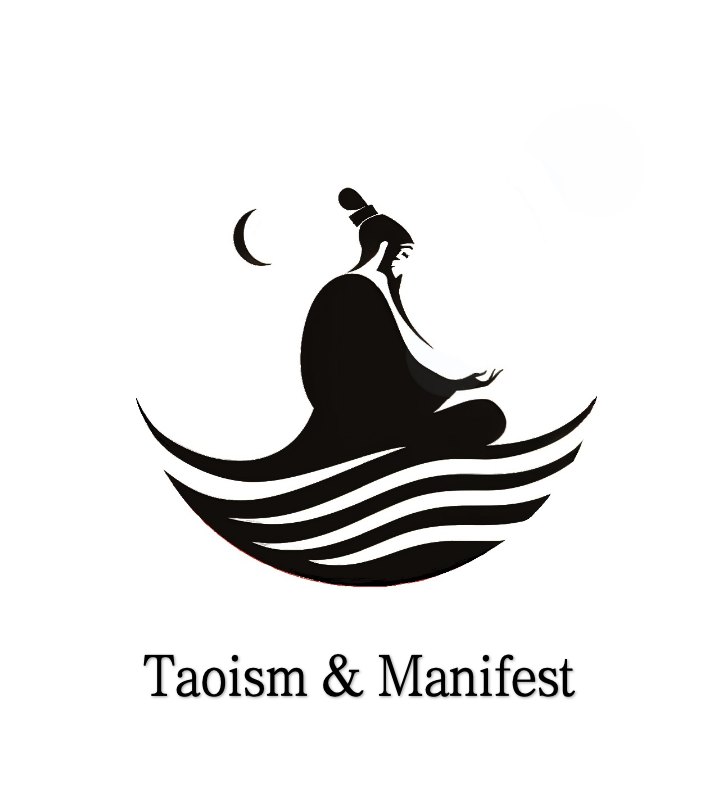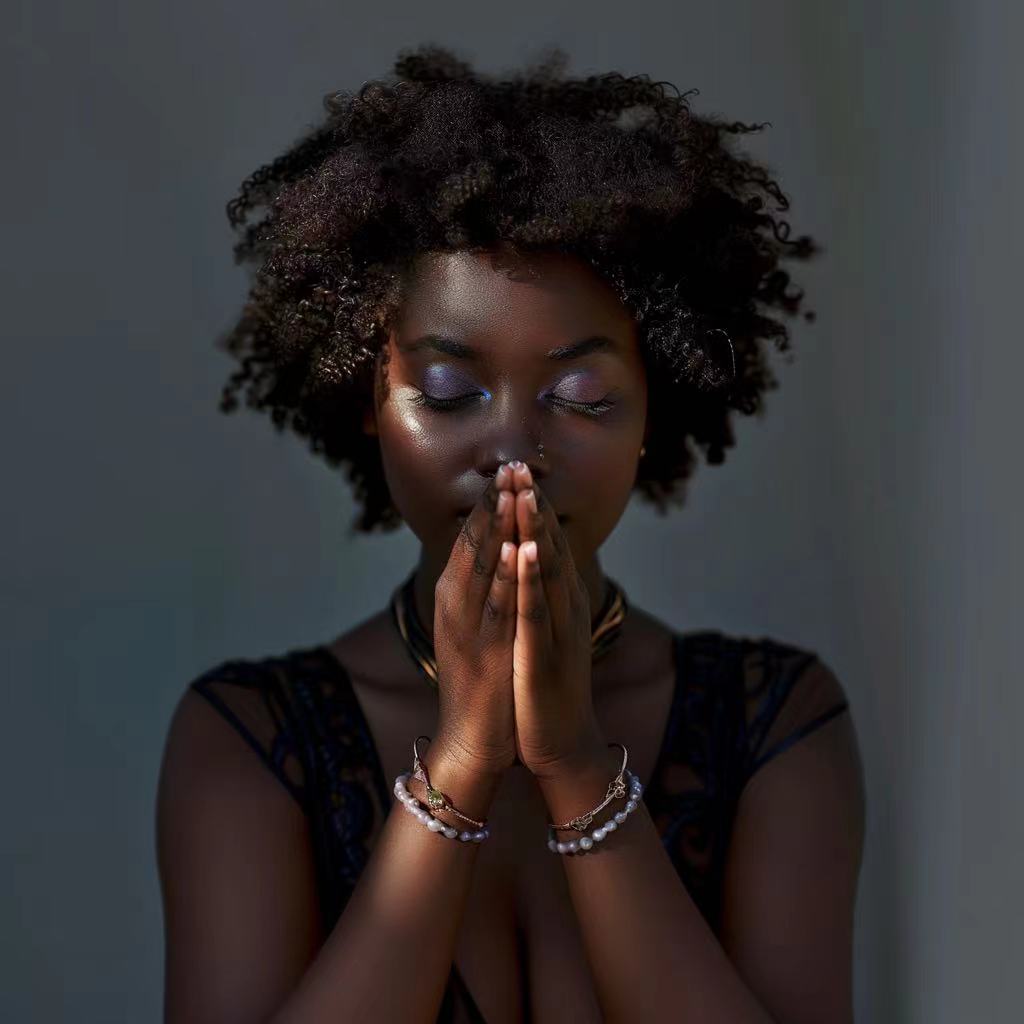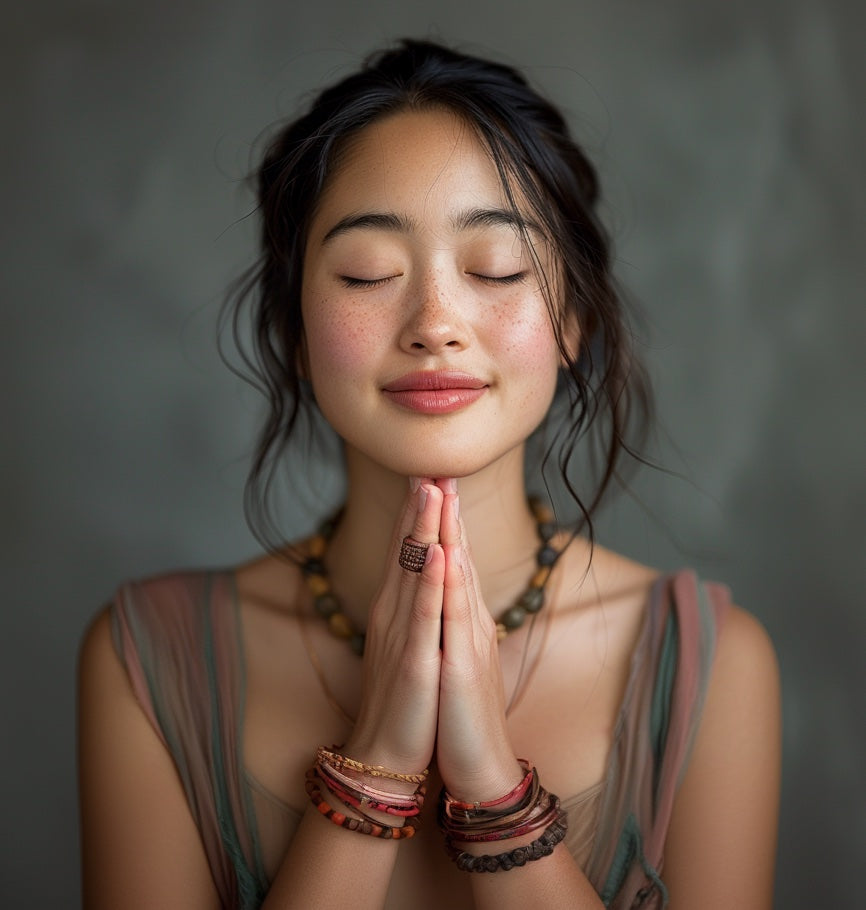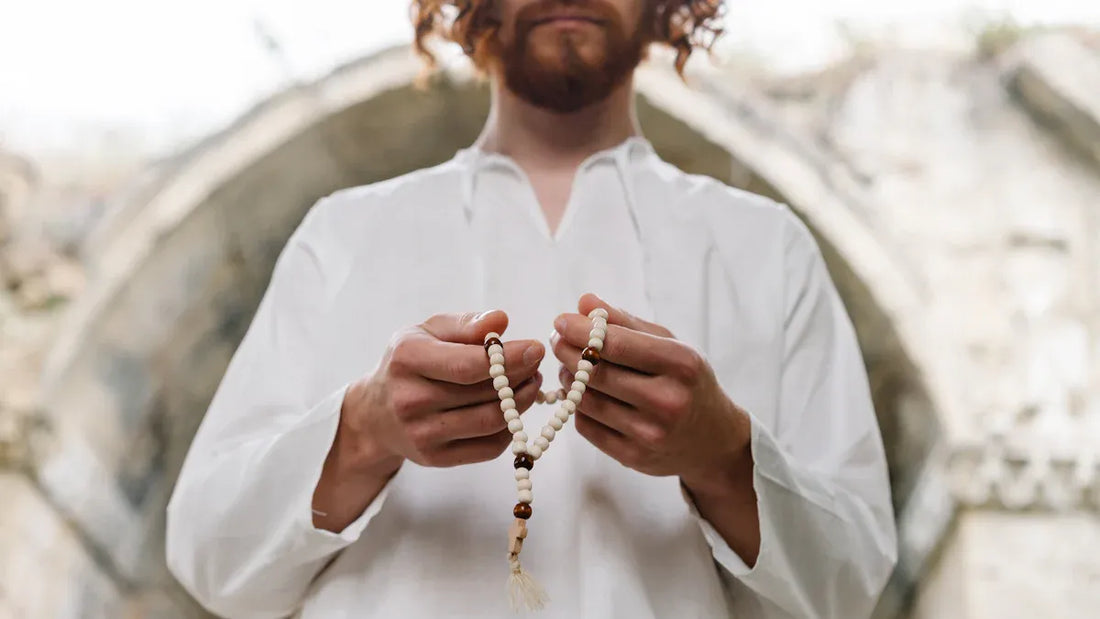
Understanding Prayer Beads: Their Historical Roots and Symbolic Meanings
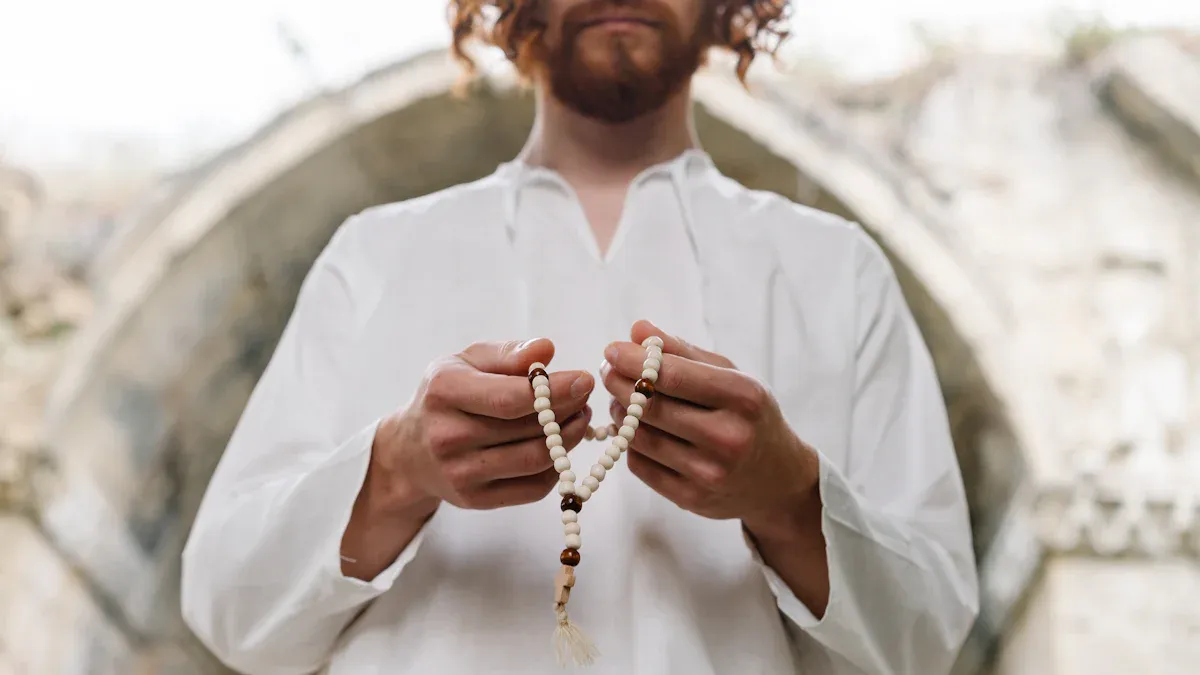
Prayer beads give you a simple tool to count prayers, chants, or mantras. You often find them in many spiritual traditions. People began using prayer beads thousands of years ago. Today, you see them in many of the world's major religions:
Christianity
Hinduism
Buddhism
Sikhism
Islam
Bahá'í Faith
Prayer beads help you stay focused during prayer and meditation. They remain an important part of spiritual practice for people seeking peace and meaning in daily life. (For a detailed exploration of how prayer beads have evolved through the ages, read What is the History Behind Prayer Beads. This article will provide you with an in-depth look at their ancient origins and historical development.)
Key Takeaways
Prayer beads help you count prayers. They help you focus during meditation. They make your spiritual practice stronger by stopping distractions.
Many religions use prayer beads in special ways. Hindu malas have 108 beads. Christian rosaries have their own patterns.
Using prayer beads can help you feel calm. They can bring peace to your daily life. They help you stay present and mindful during spiritual times.
You can pick prayer beads for their materials or meaning. Natural things like wood can help you feel calm.
Prayer beads link you to a long history in many cultures. They stand for devotion. They help you think about what is important.
What Are Prayer Beads

Definition and Purpose
You might ask what prayer beads are and why people use them. Prayer beads are strings with beads that help you count prayers or mantras. People from many cultures and religions use them to keep track of repeating special words. The use of prayer beads began long ago in ancient India. Hindus first used malas to honor their gods. Later, Buddhists, Muslims, and Christians started using prayer beads too. Each group made their own traditions and meanings for the beads.
Prayer beads do more than help you count. They help you focus your mind during spiritual practice. Moving your fingers along the beads can block out distractions. This helps you stay in the moment. Doing this can make your prayer or meditation feel deeper. Many people say using beads brings calm and peace.
Prayer beads act like a bridge between your hands and your heart. They guide you through each part of your spiritual journey.
Different religions use prayer beads in their own ways. In Hinduism, each bead can stand for a different god or goddess. Buddhists use beads made from special things, sometimes adding counters to show progress. Muslims use prayer beads to say the 99 names of God. Christians use the rosary, which has its own pattern and prayers. Every tradition gives prayer beads a special place in worship and daily life.
Here is a table that shows the main uses of prayer beads in spiritual practice:
Purpose |
Description |
|---|---|
Maintain focus |
Helps you pay attention during prayer and meditation. |
Count recitations |
Lets you keep track of prayers or mantras said. |
Promote mindfulness |
Helps you stay aware during spiritual practices. |
Organize devotional practices |
Makes your worship more organized and meaningful. |
Cultural and religious importance |
Shows spiritual value in many traditions. |
Tactile comfort |
Gives you something to touch, making prayer feel real. |
Common Features
Prayer beads come in many shapes and sizes, but they have things in common. Most sets have a string of beads, sometimes with a bigger bead or tassel at the start or end. The number of beads can be different. Hindu and Buddhist malas often have 108 beads. Islamic prayer beads usually have 99 or 33. Christian rosaries have their own pattern of beads and knots.
The materials used for prayer beads are different in each culture. Here are some common materials:
Wood: Used in Buddhist, Hindu, and Christian traditions. Wood means grounding and stability.
Seeds and Nuts: Used in Hindu, Buddhist, and Jain practices. They stand for growth and renewal.
Gemstones and Crystals: Many think these have special powers for spiritual practice.
Bone and Ivory: Found in Tibetan Buddhist and Hindu beads. They remind you that life does not last forever.
Metal: Picked for strength and protection in some traditions.
Glass and Ceramic: Sometimes decorated with spiritual symbols.
Bodhi Tree Wood: Very important in Buddhism, because the Buddha became enlightened under a Bodhi tree.
You can also see differences in how each religion makes and uses prayer beads:
Christianity uses rosaries with beads separated by knots or chains.
Buddhism uses mala beads, often knotted between each bead, for counting mantras.
Islam uses prayer beads to count Quran recitations, often made from wool or silk.
Hinduism uses beads for counting mantras, usually with 108 beads but sometimes with other numbers.
Prayer beads bring people together from many cultures and faiths. Praying with beads helps you focus, think, and find peace, no matter where you come from.
Types of Prayer Beads
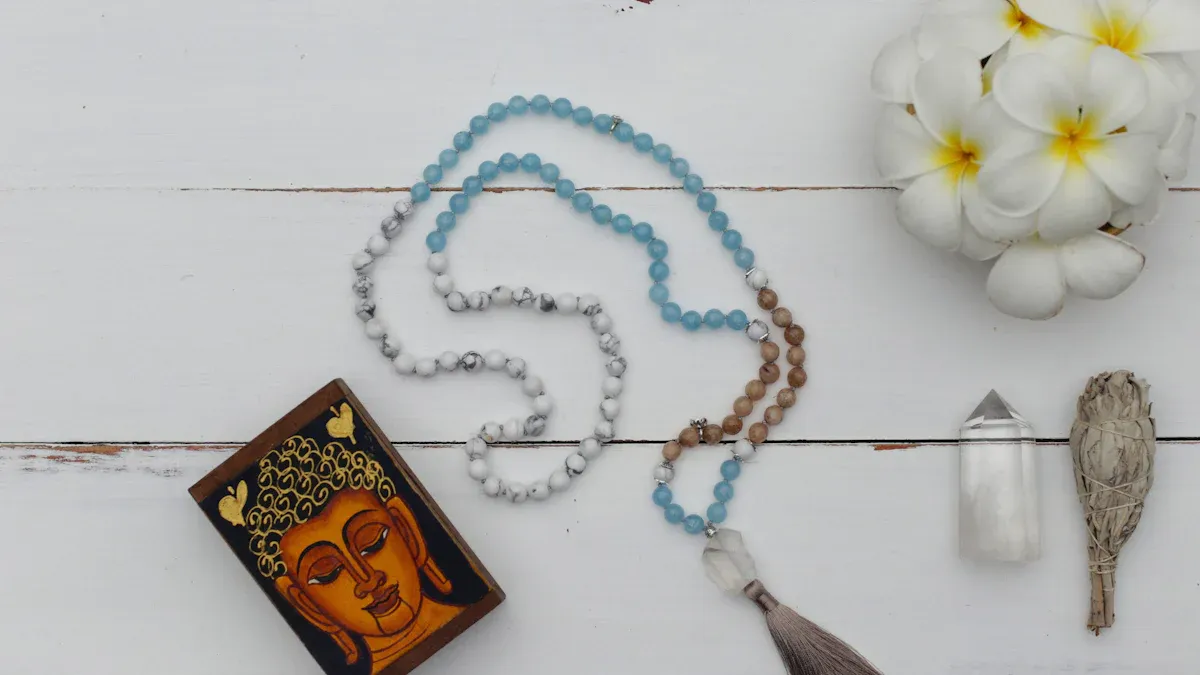
Prayer beads come in many forms across different religions. Each type has its own structure, number of beads, and special meaning. You can see these differences in the way people use them for prayer and meditation.
Hindu Mala
You will find that Hindu malas usually have 108 beads. Hindus use these beads to count mantras during meditation. The number 108 holds spiritual meaning in Hinduism. Some malas have 27 beads, which you count four times to reach 108. Most Hindu malas use seeds, wood, or gemstones. You start at the larger "guru bead" and move through each bead as you repeat your mantra.
Buddhist Mala
Buddhist malas look similar to Hindu malas. You often see 108 beads, but some have 27 beads counted four times. Buddhists use malas to count recitations of mantras or prayers. The beads help you focus and keep track of your progress. Many Buddhist malas use wood from the Bodhi tree, which reminds you of the Buddha’s enlightenment.
Islamic Misbaha
Islamic prayer beads, called misbaha or tasbih, usually have 99 or 33 beads. Muslims use them to recite the 99 names of God or other prayers. You may notice a separator bead after every 33 beads. Misbaha beads often use wood, glass, or gemstones. The structure helps you keep count and stay focused during prayer.
Christian Rosary
The rosary is a set of prayer beads used by many Christians, especially Catholics. The current form of the rosary has 54 smaller beads and five larger ones. You use the smaller beads to pray the "Hail Mary" and the larger beads for the "Our Father." The rosary beads also include a crucifix and a centerpiece medal. These parts help guide you through the prayers and mysteries of the rosary.
Each type of prayer bead set reflects the beliefs and traditions of its religion. The number of beads, the materials, and the way you use them all carry special meaning.
Here is a table that shows the main differences:
Religion |
Type of Beads |
Number of Beads |
Notes |
|---|---|---|---|
Hindu/Buddhist |
Japa Mala |
108 or 27 |
Used for mantra recitation |
Islam |
Misbaha |
99 or 33 |
Used for reciting names of God |
Christianity |
Rosary |
54 + 5 |
Used for structured prayer and reflection |
History of Prayer Beads
Ancient Origins
Prayer beads started in ancient India. This was around the 8th century BCE. Hindu seers used mala beads for meditation and prayer. Most malas had 108 beads. This number showed when meditation started and ended. Using beads became important in Hindu tradition.
Indian seers used beads for meditation and prayer long ago.
Japa mala had 108 beads to mark meditation cycles.
Prayer beads began in India before spreading to other places.
Early beads helped people count prayers and mantras. Touching each bead made it easier to focus. It helped people stay present during spiritual practice.
Spread Across Religions
Buddhism learned about prayer beads from Hinduism. This happened around 500 BCE. When Buddhism spread to Tibet, China, and Japan, beads stayed important. Buddhist malas often have 108 beads. This number stands for desires you must overcome.
Islamic prayer beads are called Subha or Misbaha. Muslims learned about beads from older traditions. Subha usually has 99 beads. Each bead stands for a name of Allah. This shows how beads crossed cultures and religions.
Christianity also started using prayer beads. Early Christians counted prayers with pebbles or simple beads. The Desert Fathers used pebbles in the Egyptian desert in the 3rd century. Later, Christians made strings of beads. This led to the rosary. The Anglican Rosary came from the Hindu mala. Prayer beads connect different faiths.
Prayer beads changed as they moved between religions. Each group made beads fit their own beliefs and rituals.
Archaeological Evidence
Archaeologists found old beads in ancient places. These finds show beads were important long before writing existed.
Bead Type |
Origin |
Significance |
|---|---|---|
Etched Carnelian Beads |
Mesopotamia |
Designs show local bead-making was valuable in the region. |
Ancient Beads with Indus Design |
Indus Valley |
Shows skill and importance of beads in Indus Valley life. |
Written records also prove prayer beads were used in many religions:
Religion |
Historical Evidence |
|---|---|
Christianity |
Early Christians counted prayers with pebbles and beads. Records go back to Abbot Paul (d. A.D. 341). |
Hinduism |
Chaplets made from Tulsi wood and Rudrâksha berries were used for prayers. Legends tell about their history. |
Buddhism |
Many kinds of prayer beads were used. Most had 108 beads and were made from wood or precious materials. |
The history of prayer beads is long and interesting. Finds in Mesopotamia and the Indus Valley show beads had spiritual and cultural meaning. Written records from religions show beads were used for prayer for thousands of years.
Prayer beads help keep culture alive. Anthropologists say beads have social and ritual uses. They help groups keep traditions and build identity. Using prayer beads today connects you to a long history shared by many cultures and faiths.
Meaning and Significance
Spiritual Benefits
Using prayer beads helps you focus better during prayer. Moving each bead keeps your mind on what you are doing. You notice your breathing and your thoughts more. Many people say beads help them feel calm and less stressed. You can use rosary or mala beads to count prayers or mantras. This habit brings peace and order to your day.
Here are some ways prayer beads help you:
They help you pay attention and stay in the moment.
The motion of your fingers can make you feel calm.
You set a goal with each bead, which helps your practice.
Using beads makes your meditation regular and steady. (Learn specific techniques to maximize the effectiveness of your meditation with prayer beads by reading How to Use Prayer Beads for Enhanced Meditation Techniques. This guide offers practical tips to deepen your meditation sessions.)
Beads made from natural things can help balance your energy.
They help you feel steady and present in your daily life.
Beads make normal moments feel special and remind you to pause.
Studies show that using beads helps you focus and feel calm. You keep track of your prayers and feel peaceful. The rosary helps Christians think about Jesus’s life. Mala beads guide meditation in Hinduism and Buddhism. Even people who do not follow a religion use beads to count breaths. Using prayer beads helps you feel more aware and healthy. (To understand more about how specifically crafted beads enhance spiritual practices, check out The Spiritual Benefits of Using Handmade Prayer Beads. This post delves into the unique qualities of handmade beads and their impact on meditation and prayer.)
Symbolism
Prayer beads have special meaning in many cultures. Each religion gives its own value to the beads, their colors, and shapes. Rosary beads help Christians remember events in Jesus’s life. In Islam, prayer beads show faith and respect. Mala beads in Buddhism and Hinduism help you focus during chants.
Religion/Tradition |
Symbolic Meaning |
Notes |
|---|---|---|
Islam |
Shows faith, respect, and holy qualities. |
Tasbih is used for Dhikr and counting Allah’s names. |
Christianity |
Helps Christians think about Jesus’s life. |
Rosaries are important in Christian prayer. |
Buddhism and Hinduism |
Used for chanting or meditation. |
Mala beads usually have 108 beads. |
Traditional African Religions |
Used for talking to ancestors and telling stories. |
Beads are part of culture and family history. |
Colors and shapes of beads also mean different things. Blue beads stand for energy and the sky. Red beads mean bravery and strength. Green beads show health and growth. Orange beads mean warmth and friendship. Yellow beads stand for the sun and new life. White beads mean purity and care. Some bead patterns tell stories about family or beliefs.
Prayer beads can show your status or beliefs. Some tribes use beads to tell stories and show who they are. When you pray with beads, you join in old traditions and symbols.
Prayer beads help you slow down and think about what matters.
Prayer beads still play a big role in spiritual life. They bring people together from different cultures and times. Ancient Hindu malas and new mindfulness tools both use prayer beads. Their meaning grows when you use them for focus or comfort. Prayer beads also help you feel peaceful.
Aspect |
Description |
|---|---|
Cultural Significance |
Prayer beads are found in many religions and modern practices. |
Personal Value |
They help you keep your devotion organized, stay mindful, and feel calm. |
When you hold prayer beads, you touch history and find your own way to think and understand. (To see how prayer beads have permeated different religious and cultural landscapes globally, visit Exploring the Global Influence of Prayer Beads in Different Cultures. This article provides a comprehensive overview of the widespread use and significance of prayer beads around the world.)
FAQ
What are prayer beads used for?
You use prayer beads to count prayers, mantras, or breaths. They help you focus during meditation or prayer. Many people say beads make spiritual practice easier and more meaningful.
Can you use prayer beads if you do not follow a religion?
Yes, you can use prayer beads for mindfulness or relaxation. Many people use them to count breaths or set intentions. You do not need to belong to a religion to benefit from them.
How do you choose the right prayer beads?
You can pick beads based on material, size, or tradition. Some people choose beads that feel comfortable or have special meaning. Try different types to see which ones help you focus best.
Tip: Natural materials like wood or seeds often feel calming in your hands.
Do prayer beads have to follow a specific number?
No, you do not have to follow a set number. Many traditions use 108, 99, or 33 beads, but you can use any number that feels right for you. The most important thing is that the beads help you stay focused.
How do you care for your prayer beads?
You can clean your beads with a soft cloth. Store them in a safe place when you are not using them. Some people keep beads in a pouch or box to protect them.
Care Tip |
Description |
|---|---|
Clean gently |
Use a soft cloth or brush |
Store safely |
Keep in a pouch or box |
Avoid water |
Protect beads from moisture |
See Also
The Spiritual Benefits of Using Handmade Prayer Beads
What is the History Behind Prayer Beads
How to Use Prayer Beads for Enhanced Meditation Techniques
Exploring the Global Influence of Prayer Beads in Different Cultures


